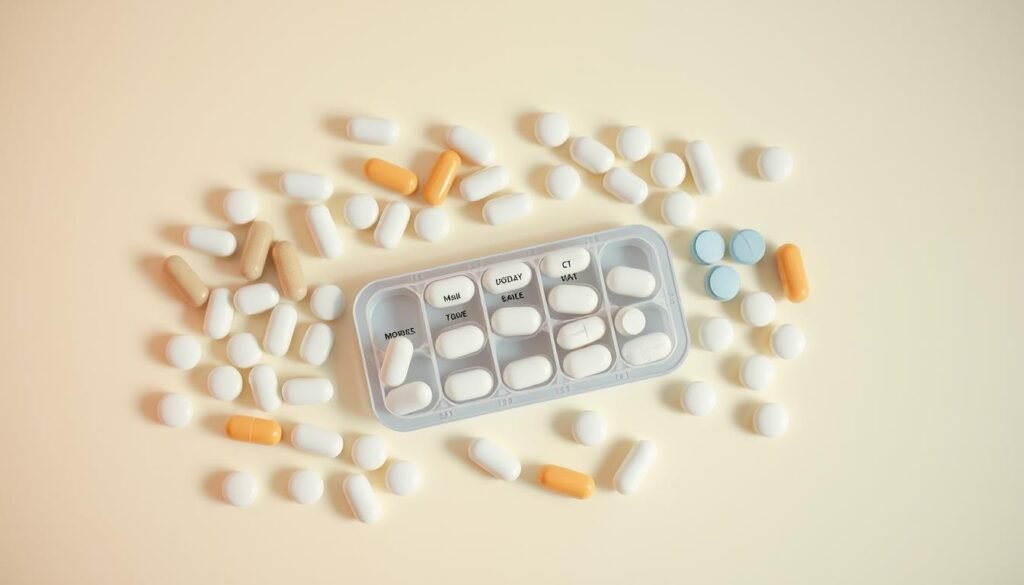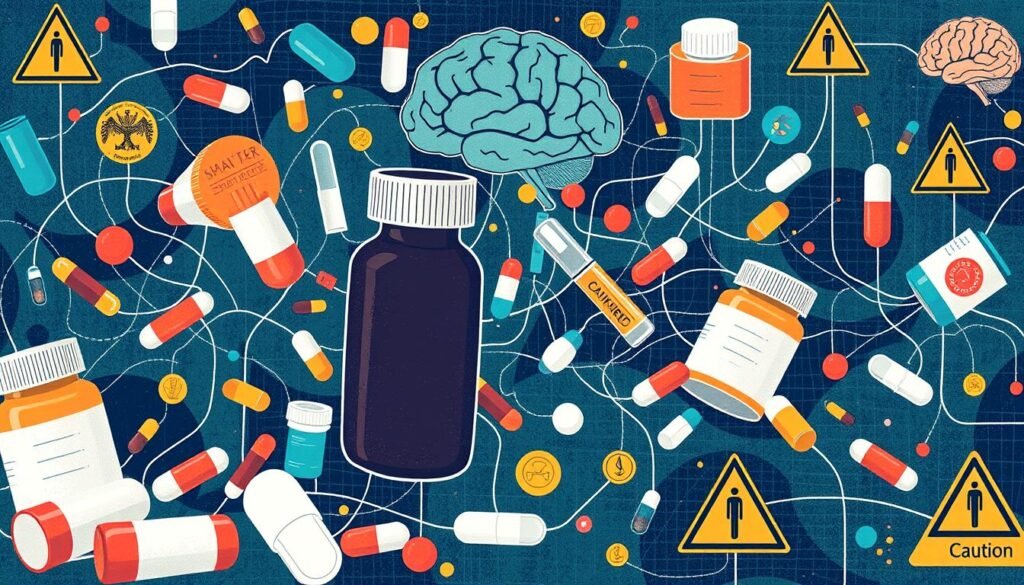It might surprise you, but over 30% of adults in the U.S. will face an anxiety disorder sometime. With more focus on mental health today, venlafaxine, known as Effexor, is a top choice for treatment. It’s called an SNRI, a kind of medicine that works for depression and anxiety. This guide will help you understand venlafaxine—how it works, when to use it, and possible side effects. It’s here to help you manage your treatment journey wisely.
Key Takeaways
- Over 30% of U.S. adults face anxiety disorders during their lives.
- Venlafaxine, sold as Effexor, is FDA-approved for anxiety treatment.
- Common side effects include drowsiness, dry mouth, and headaches.
- The standard starting dose ranges from 37.5 mg to 75 mg daily.
- It may take up to six weeks for venlafaxine to achieve full effectiveness.
Introduction to Anxiety Disorders
Anxiety disorders are common among adults in the United States, affecting over 30% during their lifetime. These conditions show up as excessive worry, fear, and restlessness. Recognizing these symptoms is crucial for proper diagnosis and treatment.
Knowing the impact of anxiety on everyday life is key to getting help. When people understand their situation, they’re likely to seek professional assistance. This can make treatments more effective and improve mental health.
| Type of Anxiety Disorder | Description | Common Symptoms |
|---|---|---|
| Generalized Anxiety Disorder (GAD) | Persistent excessive worry about various aspects of life. | Restlessness, fatigue, difficulty concentrating, irritability. |
| Panic Disorder | Recurring unexpected panic attacks, leading to intense fear. | Accelerated heart rate, sweating, dizziness, chills. |
| Social Anxiety Disorder | Extreme fear of social interactions and being judged. | Fear of embarrassment, avoidance of social situations. |
| Specific Phobias | Irrational fear of specific objects or situations. | Avoidance, anxiety when encountering the feared object. |
Treating anxiety disorders can greatly improve life quality. With therapy and medication, managing anxiety symptoms becomes possible. This leads to better mental health.
Understanding Venlafaxine and Its Mechanism
Venlafaxine acts as a serotonin-norepinephrine reuptake inhibitor (SNRI). It’s crucial in treating anxiety and depression. By increasing serotonin and norepinephrine levels, it helps maintain mental equilibrium. With proper regulation, patients usually see their mood and emotional stability improve.
This medication stops these neurotransmitters from being reabsorbed in the brain. This action boosts their activity in the central nervous system. It helps relieve anxiety symptoms. Clinical trials have shown venlafaxine is effective for panic disorder and similar conditions.
Getting to know how venlafaxine works can make users aware of its advantages and side effects. It focuses on the biochemical causes of anxiety, helping many improve their life quality.
What Is Effexor and How Does It Work?
Effexor, or venlafaxine, is a treatment for anxiety and depression. It’s approved by the FDA and works by increasing serotonin and norepinephrine in the brain. This helps balance emotions and improve anxiety management.
It tackles Generalized Anxiety Disorder (GAD), Panic Disorder, and Social Anxiety Disorder effectively. GAD symptoms like excessive worry and restlessness can disrupt lives. Effexor helps by stabilizing mood, making daily life better.
Effexor comes in immediate and extended-release forms. Dosages range from 37.5 mg to 300 mg, based on what healthcare providers find best. Patients start on a low dose, which gradually increases. This way, they can see how they react to the medicine.
Taking Effexor can come with risks, though. Some people may have side effects like nausea or dry mouth. There’s also a concern about increased suicidal thoughts early in treatment. It’s key for patients to watch for these signs, especially when starting Effexor or changing doses. For more on anxiety management with Effexor, stay informed.
Conditions Treated with Venlafaxine
Venlafaxine, also called Effexor, treats many mental health issues. The FDA approves it for major depressive disorder (MDD), generalized anxiety disorder (GAD), panic disorder, and social anxiety disorder. It offers relief to those struggling with these problems.
Doctors also prescribe venlafaxine for other mental health conditions, even if not officially approved for them. These include:
- Obsessive-compulsive disorder (OCD)
- Post-traumatic stress disorder (PTSD)
- Attention deficit hyperactivity disorder (ADHD)
- Migraine management
- Diabetic neuropathy
- Hot flashes related to menopause
Knowing about these uses shows how venlafaxine can help in many ways. It treats various mental health challenges effectively.
Venlafaxine works by balancing brain chemicals, aiding those with anxiety and depression. It helps keep their moods stable.

However, venlafaxine has some side effects, like nausea and a possible increase in depressive symptoms. Those taking it should talk with their healthcare providers. This way, they make sure the benefits are greater than the risks. This is really important because there’s a risk of increased suicidal thoughts in younger users.
| Condition | Approved Use | Off-Label Use |
|---|---|---|
| Major Depressive Disorder (MDD) | Yes | No |
| Generalized Anxiety Disorder (GAD) | Yes | No |
| Panic Disorder | Yes | No |
| Social Anxiety Disorder | Yes | No |
| Obsessive-Compulsive Disorder (OCD) | No | Yes |
| Post-Traumatic Stress Disorder (PTSD) | No | Yes |
| Attention Deficit Hyperactivity Disorder (ADHD) | No | Yes |
Venlafaxine For Anxiety: Indications and Approvals
The importance of venlafaxine for anxiety is highlighted by its FDA approval. It is approved for generalized anxiety disorder (GAD), social anxiety disorder, and panic disorder. This medicine is vital in treating anxiety disorders effectively. It helps reduce symptoms and improve emotional well-being in patients.
Venlafaxine affects brain neurotransmitters to control anxiety symptoms. Its FDA approval on December 28, 1993, was a significant milestone. It helped advance the treatment of anxiety disorders.
Doctors often choose venlafaxine for its effectiveness. They tailor treatment plans to meet each person’s needs. As highlighted in this resource, knowing venlafaxine’s uses and side effects is vital for managing anxiety safely.
Venlafaxine is a strong choice for treating anxiety disorders, with careful dose monitoring. It shows a dedication to overcoming mental health issues with proven methods.
Dosage Instructions for Venlafaxine
It’s vital to know the right dose of venlafaxine for treating different health issues. The dose is personalized by the doctor. This depends on the disorder and the patient’s health history. Following the standard dose is key to getting good results.
Standard Dosage Recommendations
The starting dose for venlafaxine is usually between 37.5 mg and 75 mg daily. This depends on the condition being treated. For major depressive disorder, this is the starting range, and it may go up to 225 mg. People with generalized anxiety disorder start with the same dose. Those with social anxiety disorder often begin at 75 mg daily. For panic disorder, treatment may start at 37.5 mg, increasing to 75 mg based on how the patient reacts.
People should take Effexor XR capsules whole with food. Adjusting the dose should be done carefully and under a doctor’s watch. Here’s a detailed look at the dose recommendations:
| Medical Condition | Starting Dosage (mg) | Maximum Dosage (mg) |
|---|---|---|
| Major Depressive Disorder | 37.5 – 75 | 225 |
| Generalized Anxiety Disorder | 37.5 – 75 | 225 |
| Social Anxiety Disorder | 75 | 75 |
| Panic Disorder | 37.5 | 225 |
Adjustments Based on Medical Conditions
Dose adjustments for venlafaxine might be needed based on health conditions, like liver or kidney function. Certain medicines can increase serotonin when taken with venlafaxine, raising the risk of serotonin syndrome. Around 90 drugs interact with venlafaxine, so talking with a doctor is essential to manage these risks.
Extra care is needed when venlafaxine is used with drugs affecting the CYP3A4 enzyme in the liver. Some combinations can lead to longer QTc intervals, needing close monitoring.
Patients should watch for signs of an overdose, such as seizures and heart problems. Stopping the medication suddenly can cause withdrawal symptoms, like dizziness and irritability. For tips on using venlafaxine correctly, click here for more details.

How to Take Venlafaxine Safely
Taking venlafaxine safely is key to good treatment results while lowering risks. It comes as extended-release and immediate-release tablets. The extended-release type is usually taken once a day with food. On the other hand, the immediate-release form might need more doses during the day. Always stick to the prescribed dose to avoid issues.
It’s important not to stop venlafaxine suddenly because it can cause withdrawal symptoms. Managing the medication correctly keeps the drug levels steady in your body. Getting regular checks is wise because venlafaxine can raise blood pressure. So, monitoring it during treatment is necessary.
Watching for drug interactions is also critical. Mixing venlafaxine with some medicines, like aspirin or ibuprofen, ups the bleeding risk. Talk often with your doctor about managing your medicines and any worries you have.
Finally, always be open with your healthcare providers about any side effects. Being upfront allows for adjustments to your treatment. This way, venlafaxine can best support your mental health journey.
Duration of Treatment with Venlafaxine
Treatment with venlafaxine can last a long time. It usually goes on from months to years. The right amount of time depends on each person’s needs and how they react to the medication. Healthcare workers say to keep using the medicine for six to twelve months after getting better. This helps avoid falling back into anxiety or depression.
It’s important to see your healthcare provider often during treatment. These visits help check on your progress and decide if you need to keep taking the medicine. Choosing to use venlafaxine for a long time means thinking about the good it does versus any risks.
Many things affect how long you should be treated, like how bad your symptoms are and how you respond to the medicine. If you need to stop taking venlafaxine, doing it slowly is best. This lessens the chance of having withdrawal symptoms. People dealing with long-term issues should follow their doctor’s advice to manage their mental health well.
| Factor | Consideration |
|---|---|
| Initial Treatment Duration | 6-12 months after symptom relief |
| Monitoring Frequency | Regular follow-ups recommended |
| Withdrawal Risk | Gradual tapering advised |
| Factors Influencing Duration | Severity of symptoms, individual response |
Possible Side Effects of Venlafaxine
Like all medications, venlafaxine can have side effects. Knowing potential venlafaxine side effects helps in managing health better. Some people might face common side effects in the first weeks. Others could face more serious issues.
Common Side Effects to Expect
Patients on venlafaxine may see several common side effects, such as:
- Nausea
- Dry mouth
- Dizziness
- Insomnia
- Sleepiness
- Constipation
- Hot flushes
- Sweating
- Headaches
These side effects typically lessen over time. Users adjust to the medication. For details on these effects, see this guide.
Serious Side Effects and When to Seek Help
Most handle venlafaxine well, but some face serious side effects. Immediate medical help is needed for:
| Serious Side Effect | Symptoms |
|---|---|
| Unexplained weight changes | Rapid gain or loss of weight |
| Menstrual irregularities | Changes in cycle or unusual bleeding |
| Hyponatremia | Headaches, confusion, nausea |
| Suicidal thoughts | Increased feelings of hopelessness |
| Allergic reactions | Swelling, rash, difficulty breathing |
Watch for serious side effects like breathing problems or unusual pain. Contact a doctor right away if these occur. Teens and young adults should be monitored for behavioral changes with long-term use.
Interactions and Precautions when Using Venlafaxine
Venlafaxine, known as Effexor XR, helps treat anxiety and mood issues. It’s important to know how it interacts with other meds. Certain drugs and substances can cause serious side effects. So, knowing what to avoid is key to stay safe during treatment.
Medications and Substances to Avoid
Some substances should be avoided with venlafaxine due to risks. Important ones include MAOIs, NSAIDs, and specific antidepressants. Here are the substances to steer clear from:
- MAOIs (Monoamine Oxidase Inhibitors) – Can lead to serotonin syndrome when combined.
- SSRI (Selective Serotonin Reuptake Inhibitors) – Increase risk of adverse effects.
- Triptans – Can contribute to serotonin syndrome.
- Alcohol – May exacerbate side effects and impair judgment.
- 5-HTP and Tryptophan supplements – Heighten the risk of serotonin syndrome.
- St John’s wort – Interaction can elevate serotonin levels dangerously.
- Blood thinners and NSAIDs – Increase the risk of bleeding.
- Gabapentin and certain antihistamines – While generally safe, they may cause increased sleepiness.
It’s crucial for patients to tell their doctors about all meds, supplements, and herbal products they use. This helps avoid harmful interactions and makes treatment more effective.

Consulting with a Doctor About Venlafaxine
Talking to a doctor is key if you’re thinking about taking venlafaxine for anxiety. A psychiatrist is important in deciding if it’s right for you. They figure out the right meds for your needs.
Having a chat about how you feel, what meds you’re taking, and side effects helps the treatment work better. This open talk makes your relationship with the doctor strong. It allows them to change the treatment if needed.
To show the good in chatting with a psychiatrist, look at this table. It shows common worries talked about at check-ups:
| Concern | Possible Outcome with Consultation | Expert Advice |
|---|---|---|
| Understanding Side Effects | Manage and minimize discomfort | Discuss alternatives if necessary |
| Medication Interactions | Prevent serious health risks | Obtain guidance on safe combinations |
| Dosing Adjustments | Improved effectiveness | Tailor dose based on individual response |
| Monitoring Progress | Ensure continuous improvement | Regular follow-ups for assessment |
Seeing a mental health expert is critical, especially with venlafaxine’s risks like higher blood pressure and withdrawal symptoms. A doctor who knows their stuff will guide you through safely. They make sure your treatment fits your mental health plan.
Conclusion
Venlafaxine for anxiety marks a big step forward in treating Generalized Anxiety Disorder (GAD). Studies show it’s effective, reducing anxiety symptoms. It also helps improve general mental health. With a 69% response rate in users of the extended-release form, it’s clear it helps many.
Despite its effectiveness, it’s key for patients to know about possible side effects. Staying in touch with healthcare providers is crucial. This is important for tracking health and how the medication works with others. For more details, check the Journal of Clinical Psychopharmacology.
Understanding how venlafaxine works for anxiety helps people make smart choices for their mental health. Ongoing research aims to uncover more about its long-term use. Patients seeking effective treatments can explore more options, such as Topamax for anxiety. This shows the variety of ways to handle anxiety, highlighting the importance of personalized treatment.